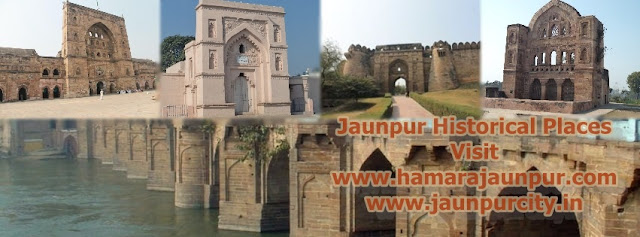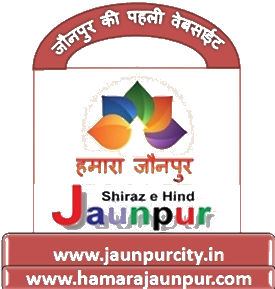By: Shahid A. Makhfi New Delhi, India Introduction- the Jaunpur Style Jaunpur, the seat of the Sharqi kingdom, is a great recluse of medieva...
By: Shahid A. Makhfi
New Delhi, India
Introduction- the Jaunpur Style
Jaunpur, the seat of the Sharqi kingdom, is a great recluse of medieval history. It is hardly 15 kms from Varanasi, yet too far from the tourist map. Dotted with early 15th century monuments, these lofty buildings display an architectural class of its own that has acquired a nomenclature for itself – the Jaunpur style.
Mughal emperor Shah Jehan admired this place as the “Shiraz of India” and rightly enough Sher Shah was one of its proud alumnus. Akbar on his visit to Jaunpur enjoyed water sports on the river Gumpti while others like Babur, Humayun and Aurangzeb were quite impressed by its splendour and did their best to restore its glory.
Sultan Firoz Shah Tughlaq
Standing halfway between Delhi and Bengal, it is an important halting point by the river side. During his second invasion of Bengal in 1359, Firoz Shah Tughlaq camped here for six months and founded this city, calling it Jaunpur after the original name Juna Khan, of his patron Muhammad bin Tughlaq.
It was not until the political confusion of the late 14th century that Jaunpur became an independent kingdom. It was a period of decline for the Tughlaqs and the violence of Timur had shattered the Delhi Sultanate in 1398. The pendulum of fortune favoured four of the Tughlaq officers who declared their independence and eked out their provincial sultanates. Malik Raja Farooqi, once a guardsman of Sultan Firoz Shah Tughlaq, founded Khandesh in 1382. Dilawar Khan scooped out Malwa in 1392. Gujarat declared independence in 1396 under Zafar Khan and the most prized province of Jaunpur was captured by Malik Sarwar, a eunuch and custodian of the royal jewellery of Sultan Firoz Shah Tughlaq.
The Sharqi Kings- Malik Sarwar and his Five Successors
Malik Sarwar had been promoted to the governorship of Jaunpur under the title of Malik- us-Shark (King of the east). When the imperial authority grew weak, his successor and adopted son, Malik Mubarak Quranfal (an Abyssinian slave) who served as the water bearer of Sultan Firoz Shah, declared independence. Sarwar and his five successors known as Sharqi kings, ruled Jaunpur for less than a hundred years and it was a period of prosperity that matched well with its architectural activity.
In order to keep their new-found kingdom, extending from the frontiers of Bengal to the foothills of Himalayas safe from the neighbours, the Sharqis maintained the largest army of that period. For the rulers of Delhi, their most formidable rival was the Jaunpur kingdom as it yielded a very rich revenue. In spite of their incessant military activity on almost all frontiers of their kingdom, the Sharqis found time for peaceful pursuits. They encouraged education and to this day Jaunpur has retained its academic importance. Kabir was a widely acclaimed poet of this era and so was Shah Mader, a mystic from Syria who had settled here and founded the Madariya order.
Malik Sarwar ruled Jaupur as a governor for five years. His adopted son Qaranfal ruled as an independent king and his brief rule was followed by that of his younger brother Ibrahim Shah Sharqi, who is considered to be one of the greatest rulers of the 15th century Hindustan whose prosperous reign of forty years produced some of the finest buildings in Jaunpur. Ibrahim was succeeded by his equally illustrious son, Mahmud Shah, who further crowned the city with monuments. During his 17 year rule, is subjects experienced the joys of life with grandeur. Traces of decline were visible with the advent of Bhikhan Khan, son and successor to Mahmud. Bhikhan was a man of tyrannical nature and thus despised by his subjects. The last of the Sharqis was Hussain Shah, whose ambition to expand beyond means brought about his downfall and that of his kingdom.
Sacrilege of the Mosques - Sultan Sikander Lodi
Jaunpur would have been far more attractive had most of its monuments not been destroyed by Sultan Sikander Lodi, whose persistent hostility towards Sultan Hussain Shah Sharqi (1458-77) made him take a vow not to leave intact any of the Sharqi memorials. Having demolished the palaces and other secular buildings, Sikander began to destroy the mosques, though he himself was a model of Muslim refinement. Finally, the cry of the clergy prevented him from further sacrilege of the mosques. What we get to see today in Jaunpur is only a fraction of the monuments erected by the proud Sharqis.
The Mughal Bridge
The first thing to catch your fancy in Jaunpur is the picturesque stone bridge over Gumpti river. For reasons best known to the Sharqis, they never thought of a concrete bridge but managed their affairs through a bridge of boats that was destined to vanish with their decline. Imagine the plight of an old woman weeping for her child on the other bank which it was not possible to reach for want of a boat or bridge. This is precisely what Akbar witnessed and lamented, “ The Sharqis erected many buildings instead of which, if they had built a strong bridge over the river, it would have been a source of their renown and fame for hundreds of years.”
Munim Khan Khan-i-Khanan understood his master’s call and ordered for an immediate construction of the bridge which took four years to complete. The Mughal bridge with a long line of ten arches and piers was supplemented with further extension of five arches in order to cover the diverted channel, which Afzal Ali –the architect from Kabul – was unable to cover. The bridge was originally provided with a Hammam (public bath house) on the northern end. It has now fallen into disuse and is permanently closed. Atop the bridge there are numerous kiosks built in 1847 by the Collector of Jaunpur.
“The bridge”, in the words of General Cunningham, “ is one of the most picturesque in India.” Its scenic beauty can best be left to imagination when the bridge often submerged during the monsoon and boats passed over it.
On the southern end of the bridge is am impressive lion climbing over an elephant representing the decline of Buddhism. Historians speculate that this zone was once a stronghold of Buddhists which finally gave way to Brahmanism as is evident from the sites of the large cities destroyed by fire on the banks of the river.
Karar Fort
Close to the bridge, on the banks of Gumpti, is Karar Fort, built in 1360 by Sultan Firoz Shah Tughlaq with materials brought in from the palace and temples of the Rathore kings of Kannauj. With the advent of Sharqis, the fortifications were further strengthened and numerous royal edifices added, but only to be reduced to rubble by the Lodis a century later.
Mughal emperors Humayun and Akbar recreated the fort after extensive repairs. Much later it was acquired by the British and once again damaged during the first war of independence in 1857, and a few years later the English blew off its 40 pillared Chil Sitoon.
The fort still offers a few interesting monuments together with the eastern gateway that has been salvaged along with a portion of the fort wall. Within the fort complex, one can visit the spacious Turkish Hammam of the Sharqis, locally referred to as Bhul-bhulian. Close to it is a three domed mosque built in a typical Bengali style with a four feet high sandstone minar in front. Arabic inscription on the minar assigns its construction to Ibrahim Naib Barbak (brother of Sultan Firoz Shah) in 1377. However, other historians read it as 1395 and credit it to Prince Ibrahim (subsequently Sultan Ibrahim) during the reign of the first Sharqi king (1395). Another six feet high pillar with 17 lines of Persian prose is placed outside the gateway. It dates back to 1769 and exhorts al Muslim and Hindu kotwals of the fort to continue the allowance, possibly to the descendants of the Sharqis. The inscription continues;
“ I administer oath to a Muslim in the name of God and His prophet; and if he is a Hindu I give him the oath in the name of Ram, Ganges and tribeni. If he does not act upon this deed he will be cursed by God and his Prophet and if God wishes his face will be blackened on the Resurrection day, and he will go to Hell.”
Atala Masjid
The earliest building to be erected by the Sharqis was the Atala Masjid built in 1408 by Ibrahim Shah on the foundation prepared by Sultan Firoz Shah Tughlaq, some three decades back. The mosque is certainly more ornate and beautiful when compared to the Tughlaq monuments. However, the Jaunpur architects added their skill and ability in blending the tall screen with battered sides that concealed the dome on the eastern gateway of the prayer hall. This arched pylon theme is a unique recurring feature of the Sharqi that veiled the dome from the front.
The Atala Masjid is divided into the central room, capped by a dome measuring 30 feet in diameter, followed by a single storeyed room on each side and there are two corner rooms in the extreme, serving as private entrance for the ladies.
Khalis Mukhlis Masjid
The next set of mosques were erected in 1430 – Khis Mukhlis Masjid and the Jhanijiri Masjid. Khalis and Mukhlis were two nobles of Sultan Ibrahim, who ordered the erection of this mosque on the pattern of Atala Masjid, save for the ornamentation that has been kept low. However, ornamentation at its best can be admired at the Jhanijiri (latticed) Masjid that has perished except for its beautiful central façade that survived the floods.
Lal Darwaza Masjid
Around 1450, Lal Darwaza Masjid was built together with a palace for Bibi Raji, the queen of Sultan Mahmood Sharqi. It was simplified reproduction of Atala Masjid, built on a smaller scale, to be used as a private mosque. Its entrance gateway is still painted red and hence its name Lal Darwaza. Besides, Raji Bibi also erected a madarsa (religious school) in the vicinity and the institution was open to all. Even today, a grand madarsa by the name of Jamia Hussainia functions in the Lal Darwaza complex. Not far from Lal Darwaza is the Sadar Imambara renovated with modern day tiles.
Masjid Jami-us-Sharq
Masjid Jami-us-Sharq, the largest and the last of mosques in Jaunpur under the Sharqis was built in 1479 by Hussain Shah, the last of the Sharqi rulers. Built on a raised terrace, the mosque follows the Atala Masjid pattern on a grander scale with fairly big halls without any pillar or support of any kind. Its erection was ordered for the convenience of a holy saint, Hazrat Khwaja Isa, who used to suffer much during his walk to Khalispur Masjid.












.jpg)




